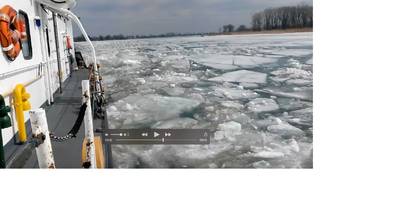USCG Conducting Ice Flushing Operations
The Coast Guard cutter fleet is flushing ice through the Great Lakes river systems to prevent ice jams and facilitate commercial shipping as the shipping season begins and the ice on the Great Lakes dissipates.
Ice breaking operations, above freezing-temperatures, and rain has caused plate ice to weaken, creating large and small ice floes through the Great Lakes and its river systems.
The Coast Guard posted a video of the Coast Guard Cutter Bristol Bay performing ice flushing operations on the St. Clair river. You can see the video here.
These ice floes, if not managed and flushed, can create thick brash ice that can clog the mouths and connection points of the rivers, which can cause significant flooding and block shipping channels.
The Soo Locks along the St. Marys River opened Wednesday, and the Welland Canal, which connects Lake Erie to Lake Ontario, as well as the St. Lawrence Seaway, is expected to open in the coming weeks, opening up the Great Lakes to more shipping traffic.
All the action throughout the Great Lakes and the weather transition from winter to spring is causing hazardous ice conditions for ice enthusiasts, so the Coast Guard is encouraging these people to take extreme caution if transiting the ice.
The Coast Guard and local agencies are reminding people who venture out onto melting and weakening ice that they are not only putting their own lives in danger, but the lives of first responders.
Ice is unpredictable and the thickness can vary, even in small areas. Water currents, particularly around narrow spots, bridges, inlets and outlets, are always suspect for thin ice. Stay away from cracks, seams, pressure ridges, slushy areas and darker areas since these signify thinner ice.
Obstructions such as rocks, logs, vegetation and pilings affect the strength of ice. Shifting and expanding ice can create pressure cracks and ridges around the obstructions.
In addition, ice near the shore of a frozen lake may be unsafe and weaker because of shifting, expansion, and sunlight reflecting off the bottom.
People walking their dogs should always keep them on a leash to prevent the pet from running out onto the ice or falling or jumping into the water.
The 1-10-1 Principle: 1 minute - 10 minutes - 1 hour
When a cold water drowning situation begins, a person has about one minute to gain control of their breathing and 10 minutes or less of meaningful movement and muscle control to get themselves out of the water. Severe hypothermia will set in within one hour, but without a life jacket, the victim is likely to drown before that occurs.
Cold Water Kills
The Coast Guard and water safety experts say public education and preparedness may help prevent cold water drowning deaths. In addition to understanding the physiological effects of cold water, people need to be aware that the initial shock of entering the cold water can cause panic and gasping, resulting in a person inhaling large amounts of water.
The public is advised to call 911 to report a person who has fallen through the ice or who is in distress in icy waters.












